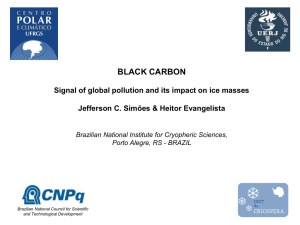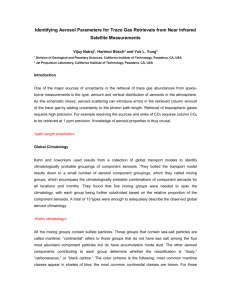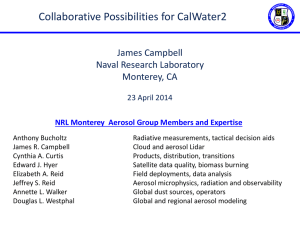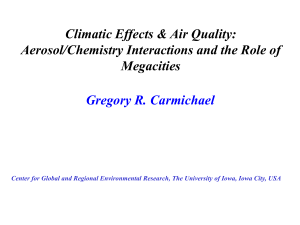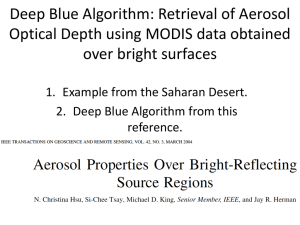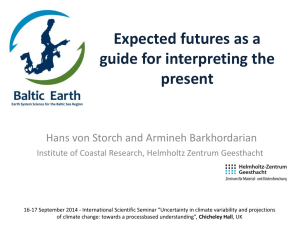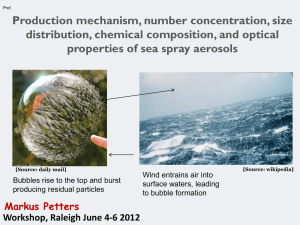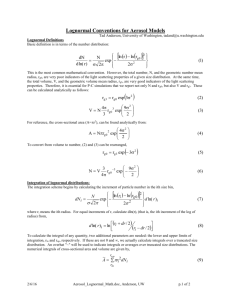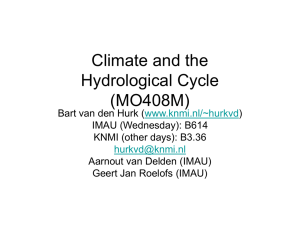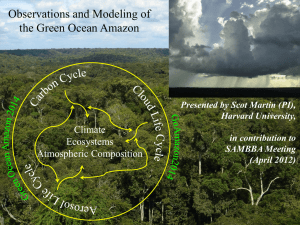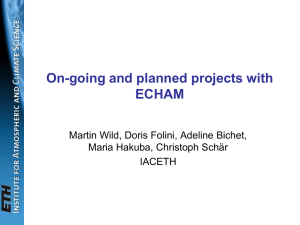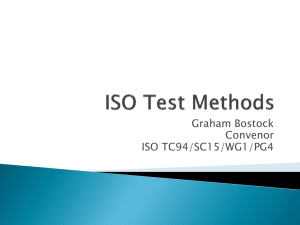Modelling short-lived climate forcers over Peninsular India: the
advertisement
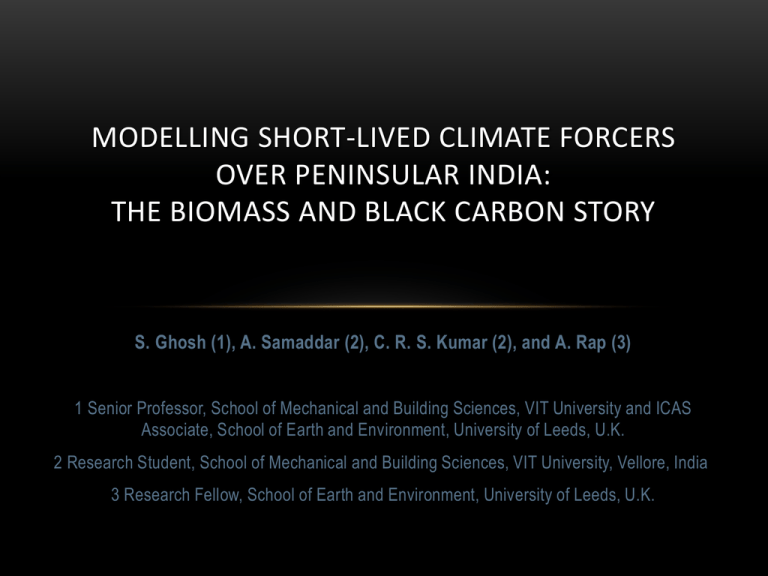
MODELLING SHORT-LIVED CLIMATE FORCERS OVER PENINSULAR INDIA: THE BIOMASS AND BLACK CARBON STORY S. Ghosh (1), A. Samaddar (2), C. R. S. Kumar (2), and A. Rap (3) 1 Senior Professor, School of Mechanical and Building Sciences, VIT University and ICAS Associate, School of Earth and Environment, University of Leeds, U.K. 2 Research Student, School of Mechanical and Building Sciences, VIT University, Vellore, India 3 Research Fellow, School of Earth and Environment, University of Leeds, U.K. TALK OUTLINE • Biomass burning and black carbon emissions • Multi-component aerosol processes • Climate modelling challenges • Interfacing research results in decision making processes • Biomass-material from living, or recently living organisms, such as wood, waste, and alcohol fuels. More than 70% of India’s population depends on biomass and about 32% of the total primary energy use in the country mainly in rural areas is still derived from biomass. In 1999 to 2000, more than 85 percent of India’s rural population was dependent on traditional fuels (biomass and cow dung-cake) for their basic energy needs. India’s goal is to provide cleaner fuels or other means of cooking to the entire population by 2012. Cooking energy consumption was estimated separately for rural and urban regions. The total cooking energy consumption for India for 2000 was 6325 PJ with rural population using about 84%. (Habib et al. 2004) • Black carbon has contributed the second largest globally averaged radiative forcing after carbon dioxide (CO2), and that the radiative forcing of black carbon is “as much as 55% of the CO2 forcing and is larger than the forcing due to the other greenhouse gasses (GHGs) such as CH4, CFCs, N2O, or tropospheric ozone.” China and India together account for 25-35% of global black carbon emissions. Black carbon emissions from China doubled from 2000 to 2006. Stratocumulus Clouds Direct Effect Aerosol particles Semi-direct Effect : BC, + Feedback (photo courtesy: UKMO) Indirect Effect : Cloud processing DISTRIBUTION OF PM10 Chennai Percentage of total population (per division) living in slums in Chennai Sathishkumar et al (2011) Highest Three hour average PM10 concentration over the study area (µg/m3) Particles from Traffic Srimuruganandan and Nagendra (2010) NATURAL SOURCES OF ATMOSPHERIC AEROSOL Volcanic Gas Plume Sulfate aerosol Sea Spray (Courtesy : S.R. Brantly) Courtesy : Google Image BIOMASS AEROSOL Vegetation Fires Source of gases and AP. Fire emissions are transported by convection into the FT and lower stratosphere and are distributed from local to the meso-scale and even to the global scale (Courtesy : Dr S. Wurzler) Q. How to model aerosol effects in climate models Develop Process Models –Parameterize? AEROSOL PARTICLES AS CCN : COMPLEXITIES AND CHALLENGES • Atmospheric aerosol particles : hydrophobic, water-insoluble but possess hydrophilic sites • Some water-soluble component (when we consider biomass aerosol internally mixed with sulphate aerosol) • Soluble gases : dissolve into a growing solution droplet prior to activation in cloud. This can decrease the critical supersaturation for activation • In-cloud oxidation of SO 2 AEROSOL MICROSTRUCTURE Diverse Size Ranges NaCl 80 μm (NH4)2SO4 Sub-micron SEM IMAGE : SEA SALT (NH4)2SO4 80 µm BIOMASS AND SOOT AEROSOL : MICROSTRUCTURE Biomass Aerosol : Leaf debris (Courtesy : Dr Gunter Helas) Soot Aerosol Chains of spherules with diameters ~ 10 nm Varghese et. al.(2011) VIT University THE MODEL • Adiabatic parcel model, fully interactive chemistry, treats nonideal behaviour of solution droplets (Pitzer calculations) (O’Dowd et al 1999) • Micro-physics : dynamic growth equations for the growth of aerosol solution droplets by condensation of water vapour on a size resolved droplet spectrum • Mass transport limitations based on Schwartz (1986). KOHLER THEORY Vapor pressure over an aqueous solution droplet : (i) Kelvin effect –increases vapor pressure (ii)Solute effect –decreases vapor pressure S=(1-B/r3)exp(A/r) =1+A/r -B/r3 A=4Mwσw/RTρw =0.66/T (μm) B=6nsMw/πρw =3.44x1013νms/Ms (μm3) KOHLER THEORY The maxima occur at the critical radius Rp=0.05μm r*=(3B/A)1/2 At this size Rp=0.5μm S*=1+(4A3/27B)1/2 MULTI-COMPONENT AEROSOL PROCESSES : PENINSULAR INDIA Ghanti and Ghosh (2010) ; Raj et.al. (2009) GROWTH PROFILE OF THE SMALLEST FINE MODE SALT PARTICLES. Ghanti and Ghosh (2010) Modelled optical properties over the three regions. Ghanti and Ghosh (2010) CLIMATE MODELLING CHALLENGES • Two aerosol components -straightforward to predict cloud droplet number concentrations. • What happens when we sandwich a third mode corresponding to biomass burning between the sulfate and salt modes? 2001 TRI-COMPONENT MODEL a (nm) σ ρ (kg/m3) Initial Spectrum Sulphate 95 1.16 1769 Smoke 120 1.12 1350 Salt (film) 100 1.32 2160 Salt (jet) 1000 1.35 2160 (salt : wind speed dependent) U=0.2 m/s Sol.=0.25 (Yamasoe et al 2000) R(nm) CURRENT MET OFFICE SIMULATIONS SENSITIVITY TO SALT LOADINGS Salt mass : 10.3-27.6 μgm-3 SENSITIVITY TO SMOKE LOADINGS Smoke mass : 0.4-2.3 μgm-3 SENSITIVITY TO SULPHATE Sulphate mass : 0.1-0.9μgm-3 Ghosh et al. (2007) Phil. Trans. Roy. Soc. A Rap, Ghosh and Smith (2009). JAS CDNC values (N cm3) before interpolation (top three panels), after modified Shepard interpolation (middle three panels) ,and after Hardy VMQ interpolation (bottom three panels). SENSITIVITY STUDIES : AEROSOL AGEING (SOLUBILITY PARAMETER) Amelioration: Policy, Planning, and Decision Making • Awareness : dissemination of knowledge-Aggressive media campaign Date:16/06/2011 CALL FOR CRACKDOWN ON BLACK CARBON • Global warming could be slowed down if governments cleaned up what's known as black carbon from industry and cooking fires • 50 of the world's leading atmospheric scientists confirmed that on June 14. From the Hindu • The full impact of black carbon is still being assessed • Linked to the melting of the glaciers in the Himalayas, • Disruption of traditional rainfall patterns in India and Africa, • Low yields of maize, rice, wheat and soya bean crops in Asia and elsewhere. • Black carbon affects climate by intercepting and absorbing sunlight, darkening snow and ice when deposited and helping to form clouds. • It is most noticeable at the poles, on glaciers and in mountain regions — all environments which are showing the greatest impact of climate change. • Another technology for reducing black carbon emissions from diesel engines is to shift fuels to compressed natural gas. • According to a study examining these emissions reductions, “there is a significant potential for emissions reductions through the [UNFCCC] Clean Development for such fuel switching projects.” • Existing and well-tested technologies used by developed countries, such as clean diesel and clean coal, could be transferred to developing countries to reduce their emissions. Phillips Design NEERI-CSIR Design SEQUESTER BC : GREEN FACADES SUMMARY : EVALUATION OF GLOBAL AEROSOL AND CLOUD MODELS-UPGRADE MODELS! Size distributed internal mixture Data assimilation Multi-component aerosol as an internal mixture Multi-component aerosol as an external mixture On-line sulphur cycle Off-line sulphur cycle Increasing complexity Role of observations vis -a- vis models is changing
